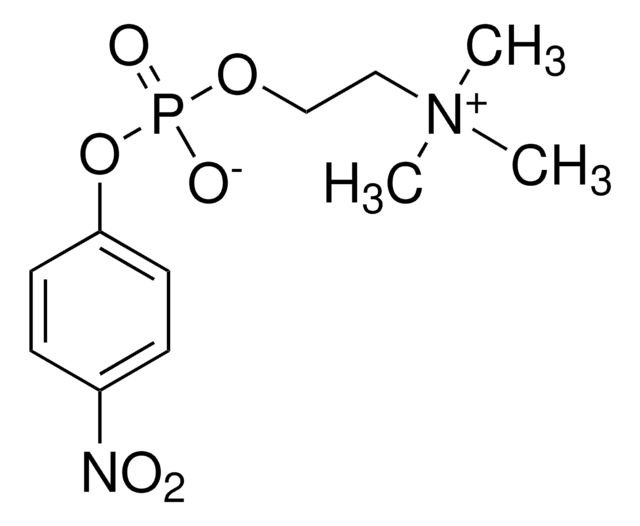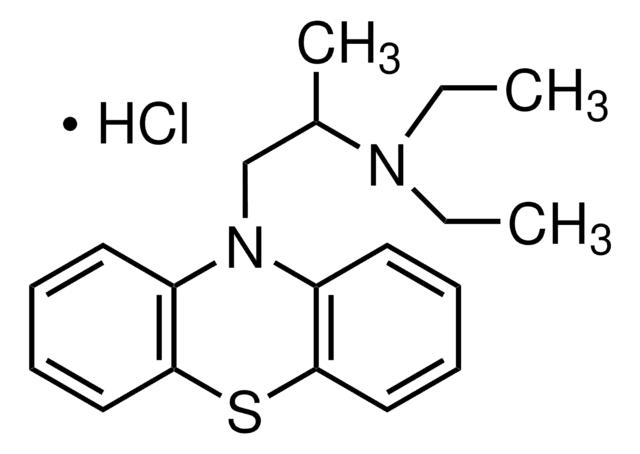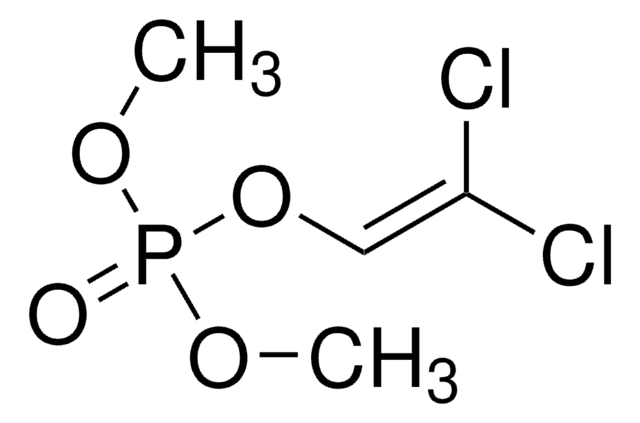추천 제품
Quality Level
분석
99%
양식
solid
mp
172-175 °C (lit.)
작용기
nitro
phosphate
SMILES string
OP(=O)(Oc1ccc(cc1)[N+]([O-])=O)Oc2ccc(cc2)[N+]([O-])=O
InChI
1S/C12H9N2O8P/c15-13(16)9-1-5-11(6-2-9)21-23(19,20)22-12-7-3-10(4-8-12)14(17)18/h1-8H,(H,19,20)
InChI key
MHSVUSZEHNVFKW-UHFFFAOYSA-N
애플리케이션
Bis(4-nitrophenyl) phosphate(BNPP) has been used as substrate to determine the enzyme activity of root phosphodiesterases of wetland plants. BNPP has been used to study the mechanism of cleavage of BNPP using oxamido-bridged dinuclear copper(II) complexes as catalysts.
신호어
Danger
유해 및 위험 성명서
예방조치 성명서
Hazard Classifications
Acute Tox. 2 Oral
Storage Class Code
6.1A - Combustible acute toxic Cat. 1 and 2 / very toxic hazardous materials
WGK
WGK 3
Flash Point (°F)
Not applicable
Flash Point (°C)
Not applicable
개인 보호 장비
Eyeshields, Faceshields, Gloves, type P2 (EN 143) respirator cartridges
가장 최신 버전 중 하나를 선택하세요:
이미 열람한 고객
M P Lim et al.
Cell death & disease, 2, e170-e170 (2011-06-10)
The major cellular event in the development and progression of liver fibrosis is the activation of hepatic stellate cells (HSCs). Activated HSCs proliferate and produce excess collagen, leading to accumulation of scar matrix and fibrotic liver. As such, the induction
Eliska Rejmánková et al.
The New phytologist, 190(4), 968-976 (2011-06-30)
Phosphorus (P)-limited plants produce higher amounts of root phosphatases, but research has mostly focused on phosphomonoesterases (PMEs). Because phosphate diesters can form a significant proportion of organic P in wetlands, we aimed to determine whether wetland plants produce both root
Studies on the reaction kinetics and the mechanism of hydrolysis of bis (4-nitrophenyl) phosphate (BNPP) catalyzed by oxamido-bridged dinuclear copper (II) complexes in micellar solution.
Xie J, et al.
Transition Met. Chem. (London), 28(7), 782-787 (2003)
Michael Subat et al.
Inorganic chemistry, 47(11), 4661-4668 (2008-05-09)
Previously reported mono- and dinuclear Zn(II), Cu(II), and Ni(II) complexes of 1,4,7,10-tetrazacyclododecane ([12]aneN4 or cyclen) with different heterocyclic spacers (triazine, pyridine) of various lengths (bi- and tripyridine) or an azacrown-pendant have been tested for the hydrolysis of bis(4-nitrophenyl)phosphate (BNPP) under
Sylvia H-C Yip et al.
Protein engineering, design & selection : PEDS, 24(12), 861-872 (2011-10-08)
Directed evolution was used to enhance the activity of the glycerophosphodiesterase enzyme from Enterobacter aerogenes, GpdQ, toward bis(para-nitrophenol) phosphate (BpNPP), a substrate that is frequently used to assay phosphodiesterases. Native GpdQ has a low level of activity toward BpNPP while
Global Trade Item Number
| SKU | GTIN |
|---|---|
| 123943-250G | |
| 123943-10G | 4061833313008 |
| 123943-1G | 4061838722652 |
| 123943-500G | |
| 123943-5G | 4061838722669 |
자사의 과학자팀은 생명 과학, 재료 과학, 화학 합성, 크로마토그래피, 분석 및 기타 많은 영역을 포함한 모든 과학 분야에 경험이 있습니다..
고객지원팀으로 연락바랍니다.












